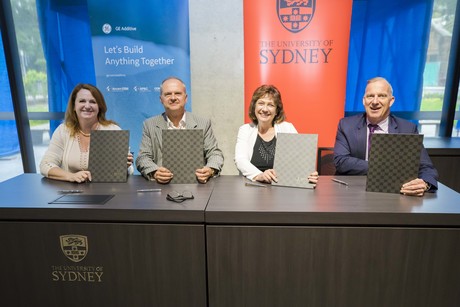GE Additive signs 10-year MoU with University of Sydney
Monday, 17 December, 2018

GE Additive has announced the signing of a memorandum of understanding (MoU) with the University of Sydney. The 10-year MoU supports the creation of the first metal additive manufacturing ecosystem in Australia — with the critical technology and people in place to drive commercial and economic opportunity, education, skills and job development — underpinned by a capacity for fundamental research.
Under the terms of the agreement, GE Additive will invest a maximum of US$1 million annually over the next 10 years in research and development, to accelerate the adoption of metal additive manufacturing in Australia and the region.
“This MoU builds on the university’s world-class expertise in the disciplines essential to advanced manufacturing such as materials engineering and integrated digital systems,” said the university’s Vice-Chancellor and Principal, Dr Michael Spence. “By partnering with GE Additive, an industry leader in additive manufacturing, we can set the agenda for this disruptive technology and ensure that Australia is primed to both participate in, and contribute to, this exciting next phase of the industrial revolution. The collaboration will drive the R&D needed to learn how this disruption to manufacturing can be harnessed for economic benefit.
“We are especially delighted that this initiative aligns with our plan to establish a new campus at Parramatta/Westmead, where advanced manufacturing will be a key focus,” he added.
“We were immediately impressed by the University of Sydney’s vision for additive manufacturing — not just at an academic level, but also because they understand the positive impact this technology can have on Australia’s economy and its workforce in the very near future,” said Debbra Rogers, Chief Commercial Officer, GE Additive. “Additive requires a completely different way of engineering and thinking. Educating and training current workforces with new skills and also getting more engineers into additive takes time and programs need to be developed over a number of years.
“The University of Sydney recognises this, and that in order to build the right mindset, the right skills, the right materials we need to encourage close collaboration between companies, academia and governments,” she continued.
The University of Sydney is committed to providing intellectual leadership in additive manufacturing over the next decade. The MoU reinforces the university’s commitment to establish a new 1000 m2 additive manufacturing and advanced materials processing research facility that will serve as a focal point for the partnership.
“This addition to the university’s core research facilities will allow our researchers and research partners to conduct trailblazing fundamental research, and will directly benefit Australian industry, particularly our aerospace, transport, biomedical and defence sectors,” said Professor Simon Ringer, Director of Core Research Facilities at the University of Sydney. “We are creating an environment for our researchers to explore the limits of what materials can do, how they are structured and how to make them. Establishing a world-class capability in Darlington is a key first step for our grand plans for advanced manufacturing in Paramatta.”
Other areas of cooperation between GE Additive and the University of Sydney include:
- funding from GE Additive to drive new R&D into material and powder technologies, sensing and analytics — building on the university’s existing advanced manufacturing and materials science research capabilities and infrastructure;
- development of new applications and potentially new additive manufacturing industries that will drive positive commercial and economic impact;
- bilateral access to GE Additive’s and the University of Sydney’s local and global networks of academic, industry and government stakeholders.
The MoU with University of Sydney complements GE Additive’s global hub-and-spoke strategic approach to research and development, which encourages partnerships with leading universities and research organisations on joint initiatives. The master research agreement included within the terms of this MoU covers three areas:
- Materials and powder technologies, including: alloy design, alloy modification, powder characterisation and powder characteristic-process response identification, post-processing optimisation and materials gaps in repairs.
- Sensing technologies and advanced materials characterisation — building on the university’s experience with electron microscopy and GE Additive’s Arcam EBM electron beam melting technology.
- Image processing and data analytics.
New liquid catalyst to transform chemical manufacturing
A major Australian breakthrough in liquid catalysis could transform how essential products are made.
Climate Smart Engineering Conference 2025: program announced
Engineers Australia says that Australia's leading voices in climate resilience,...
Aussie manufacturing conditions improve at fastest pace since 2022
S&P Global has reported that Australia's manufacturing sector experienced its strongest...








